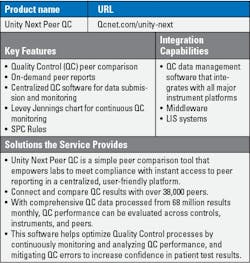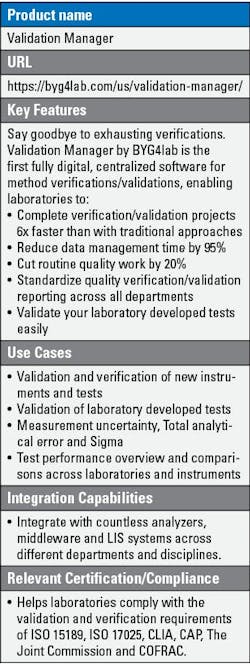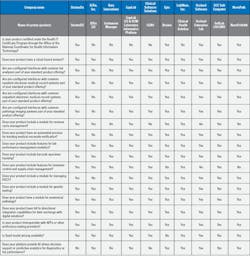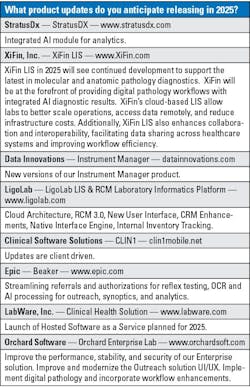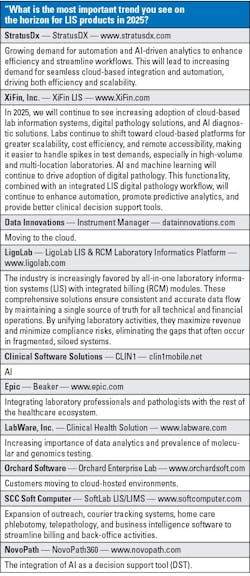Choosing the right laboratory information system (LIS) is a challenging process for laboratories everywhere. Recent technology advancements like artificial intelligence (AI) and machine learning, cyberattacks, and an increasing demand for cloud-based solutions have all affected the LIS market.
Medical Laboratory Observer (MLO) interviewed five LIS experts to better understand the current trends and challenges they’ve observed in the LIS market this year.
Gilbert Hakim, CEO of SCC Soft Computer said, “We saw a significant increase in genetic testing performed in client labs instead of sending it to reference labs. Of course, the labs need to understand that the EMR vendor cannot correctly bill for these specialized tests and should rely on the LIS vendor's billing services to do so. We can actually do this billing very well. And we can now perform these billing services for customers with a different LIS.”
Suren Avunjian, LigoLab Co-Founder and CEO highlighted the rise of cyberattacks in 2024. “This spike in attacks underscored the urgent need for enhanced cybersecurity measures. As we head into 2025, implementing strategies like two-factor authentication (2FA), immutable backups, and comprehensive disaster recovery plans are no longer optional but essential components of a robust cybersecurity posture.”
“One of the trends that we saw in 2024 was the fact that labs are having to deal with staffing shortages and are turning to technology to help them do that—using the LIS to gain workflow efficiencies, adopting more automation,” said Kim Futrell, MLS(ASCP), MSHI, CPMM, Senior Strategic Marketing Manager, Orchard Software.
Other trends she noted were, “The adoption of digital pathology is causing labs to begin moving to anatomic pathology laboratory information systems with the ability to optimize digital pathology workflows,” and “The growth in molecular testing continued to drive the adoption of more comprehensive, mature, and reliable molecular information systems.”
Technology advancements
MLO asked LIS experts how recent technology advances have impacted LIS and what future developments they are excited about.
AI is one of the most significant advancements in the history of pathology, according to Joseph Nollar, AVP of LIS Product Management, XiFin, Inc. “During the pandemic, we saw an increase in requests to integrate digital pathology solutions. This was driven by the FDA changing its guidelines to make it easier to install systems so pathologists could work remotely. Post-pandemic, the primary driver of the growth in digital pathology has been FDA-approved diagnostic algorithms driven by AI. We are particularly excited about the continuing growth and expansion of diagnostic algorithms that will provide additional diagnostic insights, assist pathologists in their diagnosis, mitigate risk, and improve lab productivity. The LIS has a key role in facilitating a fully integrated digital pathology workflow with the ability to integrate AI-generated diagnostic results.”
Ed Krasovec, Director – Clinical Solutions, LabWare, Inc. said, “Because of the need to transform the large (and increasing) volumes of data that are being tracked into actionable information, data analytics generally is a hot area of interest across many categories of software, including LIS.”
Avunjian emphasized, “This is an exciting time as advancing technology supported by modern laboratory information system software has the power to push lab operations and finances to new levels of efficiency and improve patient care.”
He pointed to the following “positive impacts that AI and machine learning are already having on laboratory workflow management:
· Automated data entry: AI-powered OCR technology can extract data from handwritten or printed forms, reducing manual data entry, minimizing errors, and speeding up turnaround times.
· Automated data entry and coding: AI-powered systems can automatically extract relevant information from laboratory information systems and assign appropriate billing ICD and CPT codes. Machine learning algorithms can learn from historical data to improve coding accuracy over time.
· Workflow and process optimization: AI algorithms can analyze workflows to identify bottlenecks and suggest improvements, enhancing efficiency by automating repetitive tasks and integrating data from multiple sources.
· Automated result validation: Machine learning models can validate test results by comparing them against historical data, flagging anomalies, and reducing the likelihood of human error.
· Predictive analytics for denial management: Machine learning models can predict which claims are likely to be denied based on historical data. This allows lab billing teams to address potential issues before submission, increase claim acceptance rates, and reduce the time spent on resubmissions.”
Integration challenges
Navigating the change is one of the most common challenges laboratories face when integrating a new LIS, according to Nollar. “Lab staff are often resistant to change and may struggle with acceptance of a new system. Sometimes staff make requests to make the system behave like the old system that is being replaced, even when this undermines the new system’s operational improvements.”
He continued, “It is important to embrace your new system and all the new benefits and features that come with it. LIS providers, on the other hand, need to make sure that their system is adaptable to client needs regarding workflow and data configurations.”
Hakim and Krasovec both said resources are a barrier. “Common challenges include difficulty in devoting necessary resource bandwidth of key subject matter experts to the implementation to provide input to the project, underestimating the effort related to inputting the lab’s master data dictionaries, and the tendency to replicate a legacy LIS solution rather than embracing the out of box behavior of the new LIS solution,” Krasovec said.
Hakim added, “These systems are being replaced because they are antiquated, and the vendor is not advancing the system to accommodate today's demands on an LIS. With laboratory staffing shortages, we focus on automation to reduce the amount of human intervention required to perform testing workflows. Often, we augment customer staffing to implement the new laboratory and genetics software to meet timelines. To expedite implementation, we use a best-practice model database for dictionaries, instruments, and workflows to reduce the timeline and cost.”
Data security
Futrell pointed to the significance of data security to healthcare information systems and shared best practice strategies Orchard Software recommends for data management. “Orchard Software recommends that our solutions be deployed in a healthcare-centric data center that provides the secure design, business continuity, and disaster recovery that is required by federal healthcare data regulations.”
She continued, “If the solution is hosted by Orchard Software, our cloud-deployed solutions are housed in Amazon Web Services (AWS) cloud instances. AWS supports 143 security standards and compliance certifications, including PCI-DSS, HIPAA/HITECH, FedRAMP, GDPR, FIPS 140-2, and NIST 800-171, helping customers satisfy local, state, and federal requirements for data protection and security. Orchard Software maintains a SOCII type 2 certification status and leverages AWS certifications and accreditations, demonstrating compliance with rigorous international standards.”
Recent high profile ransomware attacks have highlighted the need for stronger cybersecurity measures because healthcare organizations, including clinical labs, are attractive targets for cybercriminals, said Avunjian. “To combat these threats, providers must first adopt their own robust cybersecurity strategies, and then, just as importantly, partner with laboratory information system companies that emphasize the importance of cybersecurity and offer practical and relatively inexpensive solutions.”
Cloud-based solutions and the future of LIS
When asked what role cloud-based solutions will play in the future of LIS, Krasovec said that “many labs are finding advantages in outsourcing their IT infrastructure to cloud providers so that they can focus on their lab operations and not on IT.”
“The benefits of doing this are significant: improved security and compliance, reduced IT manpower, improved scalability & flexibility, and more,” he continued.
On the contrary, “The challenges we see include confusion related to differences between cloud hosting, SaaS (Software as a Service), IaaS (Infrastructure as a Service), and PaaS (Platform as a Service) and what the implications are for each of these options to the lab with regard to their IT responsibility and the flexibility or lack thereof to customize their LIS application.”
Hakim said, “Over the past four years, requests for cloud-based LIS solutions have significantly increased. Some of our largest commercial labs have now deployed our LIS and Genetics software in the cloud. Many clients are shifting from “On-Prem” to cloud-hosted solutions. The most crucial factor is that the same software currently running in your LIS can be ported to a cloud-hosted solution. It is important not to introduce disrupters during this process. Most of our customers using courier, logistics, CRM, and supply chain management software are now cloud-hosted.”
Cloud-based solutions can increase the security of protected health information, Futrell added. “Offloading the bulk of security measures to a cloud vendor makes data more secure and reduces the burden on the organization’s IT staff. Healthcare organizations (HCO) that use a cloud-based information system can obtain a cost-effective IT solution without the capital layout or expenditure for internal IT staff to maintain and service the infrastructure. A subscription service levels the cost curve and eliminates costs peaks that occur across time. Cloud systems increase data redundancy and system availability (or uptime) by automating backups and disaster recovery options. This added data protection means that an HCO does not lose vital patient data and can minimize downtime.”
Considerations
Nollar concluded, “An LIS is one piece of the laboratory infrastructure puzzle. Often, it is selected, implemented, and used by those who have a primarily clinical lens. Sometimes, this approach omits the possibility of really advancing the lab’s automation from the first patient encounter to the lab result to a claim that is fully paid.”
“Today's LIS must consider all of the inputs needed by the leading revenue cycle management solutions to ensure that claims are submitted without errors and have the necessary supporting information for the claim to be adjudicated in a timely and efficient way. Today's LIS should be capable of transmitting the necessary information for claim submission, including prior authorization numbers from payors as just one example. Gone are the days of selecting, contracting, implementing, and using an LIS without considering the end-to-end experience for the ordering physician, the digitally savvy patient, and the downstream reimbursement and payment mechanisms.”
Training and onboarding
Implementing a new LIS can be challenging. We asked Avunjian, Futrell, Hakim, Krasovec, and Nollar how they approach training and onboarding for new users of your LIS, and what resources are available to support them.
LigoLab
“LigoLab treats LIS implementation as a strategic partnership with its customers, aiming for long-term alignment and success. The implementation process begins with a kick-off call to outline timelines, dependencies, and milestones. A test environment is created for initial configurations, followed by a domain analysis to assess workflows and identify gaps and phases of implementation, resulting in an implementation blueprint.
The configuration process, which may take 2-6 months depending on lab size and complexity, involves setting up the LIS to meet the lab's unique needs. During this period, selected test cases are processed to validate the system and train staff. The interfacing and data import teams ensure a smooth transition by analyzing current interfaces and importing historical patient data.
In anticipation of go-live, LigoLab employs a dedicated implementation team to ensure 100% success. One week before going live, parallel testing occurs, and the LIS system is prepped for full use. The transition happens over a weekend, with historical data imported, test data deleted, and the production environment launched. LigoLab staff remain on-call during and after the go-live to provide training and support, ensuring a smooth transition.
LigoLab’s LIS system training is implemented during the implementation phase to cover essential operations for going live, with additional training available post-go-live for more advanced features. LigoLab emphasizes knowledge transfer to empower users to operate independently.
All training sessions are recorded and shared, along with tutorial videos on general topics. Users also have access to extensive online help documentation that includes thousands of searchable help pages covering all aspects of the LIS platform.
Post go-live, LigoLab also hosts regular user group forums (in-person and via conference call) and encourages users to join its Client Advisory Board and provide customer feedback that leads to continuous system improvements.”- Suren Avunjian, LigoLab Co-Founder and CEO
Orchard Software
“At Orchard Software, we know that the better trained our customers are, the better they can use their LIS to support their mission. To maximize understanding of Orchard's products and help ensure best use, we offer several training options, including training for system administrators, advanced users, and end users.
Instructor-led training classes are held throughout the year. These C.E.-qualifying courses give users hands-on experience with the latest new features of their specific Orchard products and help them get more from existing features, maximizing efficiency with tips and shortcuts. Attending training classes also allows users to ask questions and exchange ideas with other users.
Additionally, Orchard offers Orchard eLearning, a subscription-based library of end-user-focused courses meant to help labs train end users. This training supplements instructor-led training. While instructor-led training aims to teach how to configure your Orchard system, Orchard eLearning shows how to perform day-to-day tasks in the system.”- Kim Futrell, MLS(ASCP), MSHI, CPMM, Senior Strategic Marketing Manager Orchard Software
SCC Soft Computer
“COVID challenged LIS vendors to be more creative with training and implementing systems during the pandemic. Zoom, MS Teams, WebEx, and other tools were used extensively to carry out tasks remotely that would have normally been performed ‘on-site.’ Evaluating a client’s needs prior to project commencement is very important in determining the training requirements. We utilize a Hybrid (On-site/remote) approach, which has proven to be successful.”- Gilbert Hakim, C.E.O. of SCC Soft Computer
LabWare, Inc.
“Our training approach includes 1) classroom training for the system administrator and power users at the beginning of the implementation project; 2) mentoring of the admin and power users by our professional services team during the implementation; and then 3) Train the trainer for end user training prior to go-live. We can also deliver or assist with the delivery of end-user training if need.”- Ed Krasovec, Director – Clinical Solutions, LabWare, Inc.
XiFin
“Training and onboarding of new users is critically important to the success of the implementation and the ongoing client experience and product satisfaction. During the implementation, the XiFin team does a combination of on-site and remote training to ensure all user groups (administrators, accessioners/customer service, lab techs, pathologists, and others) are familiar with the features and functionality of the system. XiFin also employs a train-the trainer methodology to ensure that client administrators are experts in the system and can help train the rest of their team. We also provide online resources including how-to guides, training videos, and manuals via XiFin University. To further assist in training efforts, clients can also request ad-hoc training from the customer service team at any time.”- Joseph Nollar, AVP of LIS Product Management XiFin, Inc.
2025 predictions
As part of our annual LIS survey, MLO asks vendors what they see on the horizon for LIS products. Avunjian, Futrell, Hakim, Krasovec, and Nollar gave their 2025 predictions.
Suren Avunjian, LigoLab Co-Founder and CEO
“Laboratory information system and laboratory billing system integration within one advanced informatics platform will go from a new concept to a fast-growing trend in 2025.
Clinical labs and pathology practices face challenges such as shrinking margins, evolving regulations, complex payer requirements, labor shortages, and rising costs. An all-in-one LIS system and lab revenue cycle management (RCM) platform can insulate a lab from these threats by making it highly efficient and by stopping revenue leakage.
An all-in-one integrated LIS and RCM platform ensures consistent and accurate data flow by maintaining a single source of truth for orders, results, and lab billing information. This eliminates redundant data entry and discrepancies between multiple disparate systems that result in denials and delayed payments.
LIS and RCM integration leads to quicker billing and faster reimbursement cycles by linking technical and financial operations into one comprehensive data entity while embedding real-time access to third-party services that specialize in patient demographic verification, insurance eligibility, insurance discovery, claim submission, and claim status.
An all-in-one platform simplifies compliance with regulations like HIPAA and CLIA by ensuring all transactions are traceable and secure while also providing comprehensive and easily accessible analytics and operational insights that the lab can use to eliminate bottlenecks and improve processes.
An integrated platform reduces IT maintenance costs by eliminating the need for multiple software licenses and support teams. A platform such as this also optimizes resource utilization and automation that reduces administrative overhead.
An integrated LIS and RCM platform is also much more adaptable to changes to billing codes, regulatory requirements, demographic updates, and lab services, all of which better supports lab growth and scalability when compared against multi-system solutions.
By integrating the LIS system and lab revenue cycle management workflow into one source of truth backed by intelligent automation, labs will truly help themselves in 2025 by improving efficiency, accuracy, compliance, and financial performance.”
Kim Futrell, MLS(ASCP), MSHI, CPMM, Senior Strategic Marketing Manager Orchard Software
“Cloud services (hosting) will become increasingly important as labs seek more reliable and secure solutions and to reduce their overall IT costs. Vendors that offer managed cloud services/hosting solutions will have a significant competitive advantage.
Larger labs will continue to adopt enterprise laboratory information systems with the breadth (across multiple disciplines) and scalability to support their growth.”
Gilbert Hakim, C.E.O. of SCC Soft Computer
· “Expansion of outreach
· Courier Tracking Systems
· Home care phlebotomy
· Telepathology
· Business Intelligence software to streamline billing and Back Office activities.”
Ed Krasovec, Director – Clinical Solutions, LabWare, Inc.
“As we look toward 2025, we anticipate that manpower shortages and an aging workforce will drive continued interest to advance laboratory automation, and this will incentivize a growing number of labs to take advantage of LIS administrator staff augmentation services offered by LIS providers.”
Joseph Nollar, AVP of LIS Product Management XiFin, Inc.
“In 2025, we will continue to see increasing adoption of cloud-based lab information systems, digital pathology solutions, and AI diagnostic solutions. Labs continue to shift toward cloud-based platforms for greater scalability, cost efficiency, and remote accessibility, making it easier to handle spikes in test demands, especially in high-volume and multi-location laboratories. AI and machine learning will continue to drive adoption of digital pathology. This functionality, combined with an integrated LIS digital pathology workflow, will continue to enhance automation, promote predictive analytics, and provide better clinical decision support tools.”


